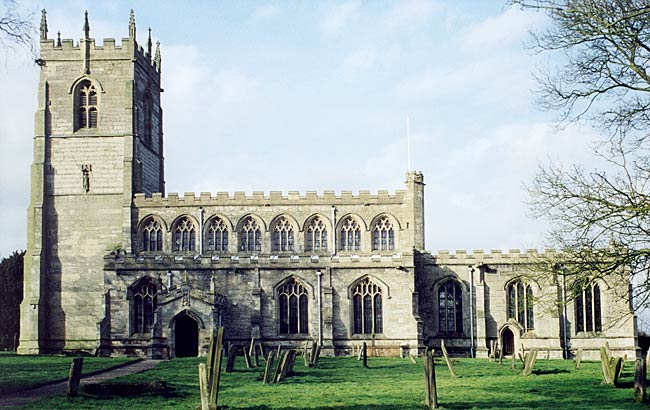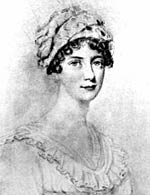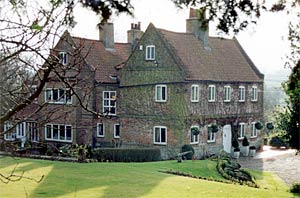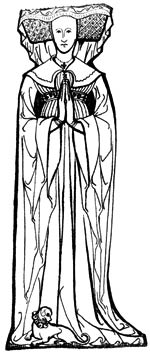< Previous | Contents | Next >
The Fall of a King
EAST MARKHAM. Its orchards make it pleasant, it has two old windmills hard by, and memories of famous folk cling to two of its houses and its noble church.

East Markham church in 2003.

Elizabeth Cartwright.
One was a gracious lady who wrote books for children, and a history book without stories of cruel things, showing her love for the village by using Mrs Markham as her pen-name. She was Elizabeth Cartwright, whose father invented the power loom, and she spent much of her early life with her aunts at the big red house known as East Markham Hall. She has been sleeping in Lincoln Cathedral since 1837, but is remembered here by a window in the church.

The Manor, East Markham, in 2003.
In the stone foundations of the manor house close to the church are remains of the old home of two famous judges of the Markham family, father and son. The father was Sir John, who helped to change the line of kings by drawing up the document for deposing Richard the Second. The thought that he lies here carries the mind back to one of the most dramatic scenes in history and one of the most moving scenes in Shakespeare:
What must the king do now? Must he submit?
The king shall do it. Must he be deposed?
The king shall be contented. Must he lose
The name of king? O' God's name, let it go:
I'll give my jewels for a set of beads,
My gorgeous palace for a hermitage,
My gay apparel for an almsman's gown,
My figured goblets for a dish of wood,
My sceptre for a palmer's walking-staff,
My subjects for a pair of carved saints,
And my large kingdom for a little grave,
A little, little grave. . . .
It was Judge Markham who gave the deposition of King Richard its legal basis by drawing up the document, and here they laid him when his exciting days were over; he lies in the chancel under an alabaster tomb with an inscription and plain shields. His son John, known as the Upright Judge, is said to have lost office through carrying out his maxim that no subject can be arrested by the king for treason. He sleeps in Lincolnshire.

Brass of Dame Millicent Meryng (1419).
Set in a floor stone in the south aisle is a beautiful brass portrait of the first Sir John's widow, who after his death married William Mering. The brass shows her in a high-waisted gown with hanging sleeves and a wide collar reaching to her shoulders. Her embroidered headdress is wired so that it looks rather like a canopy, and her hands are at prayer. The little dog at her feet, with bells on its collar, is charming.
In memory of the two Markham judges the east window of this aisle was renewed and filled with stained glass by their descendants last century. It has shields of arms and medallions of foliage; three of the shields are pf old glass, and among old fragments in the tracery is St Scyth crowned. Of two other windows here (filled at the same time with similar glass), one is in memory of Elizabeth Cartwright and has old fragments in the tracery; the other is to John Kirke, a soldier of Trafalgar days, and his three sons, who died serving their country.
The chancel is beautiful with its modern glass. The east window, shining silver and gold, blue and green, has Mary and Jesus, St Hugh and his goose, John the Baptist, and St Cuthbert. Splendid figures of St Alban, St George, and St Martin, with small scenes from their lives, look out from a window in memory of Kenneth Markham Rose, who fell in action in West Africa in 1915. He was the only son at the manor house.
A great delight inside and out is the clerestory of 16 triple windows, a glorious traceried lantern which helps to fill this spacious place with a blaze of light. It is a worthy part of a 15th century embattled pile which is one of the finest churches of this countryside.
Eight pinnacles and gargoyles like winged demons adorn the massive tower, which has transomed windows, a recessed doorway, an archway of great height opening to the nave, and a small figure in a canopied niche. Projecting far from the chancel buttresses are four extraordinary gargoyles—a winged animal, a grotesque with a rope round its shoulder, a creature in armour with a battle-axe, and another with staring eyes and one hand in its wide-open mouth. In the gallery of heads at the windows are a king and a queen, a bishop, a lady in a frilled headdress and a crusader. On a battlement is an old sundial.
Great heads look out from the nave arcades with channelled pillars. Much of the old work is left in the oak screen of the south aisle, the old pulpit has carved borders, an old pillar almsbox has iron bands, and worked up into the Litany desk is part of an old bench-end carved with the head of a bishop, vines coming from his mouth. He is hidden from the casual eye. The modern roofs have rich bosses and carved borders, and on the ends of the nave beams are angels and heads of human folk, one a man with his tongue out.
Very striking is the massive and unusual font, looking like a giant spider, with a bowl of 1686 and a 14th century base which has a central pillar and eight legs bent outward, their feet resting on a stone carved with four-leaved flowers. It is crowned by an elaborate pyramid cover.
Set up in the north aisle is the ancient altar stone. We read in the church that its presence near the chancel arch was revealed to a vicar in a dream the year before it came to light in 1897.
